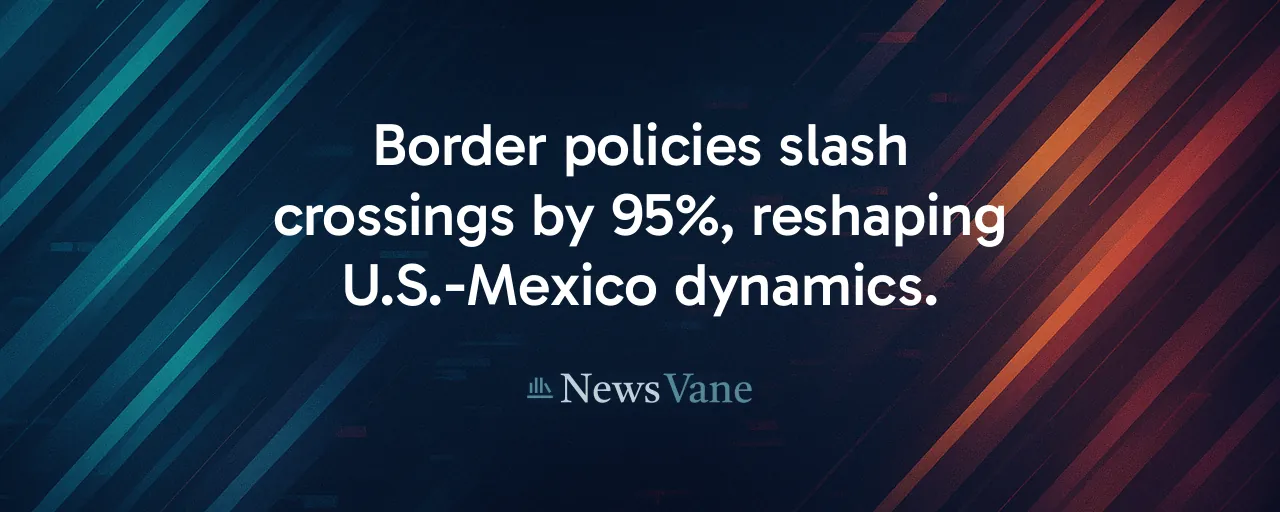A Shifted Landscape Sparks Questions
The U.S.-Mexico border looks different in 2025. Once a hub of constant movement, it now sees far fewer crossings. Border Patrol data shows monthly apprehensions dropping from over 100,000 in 2024 to under 10,000 by March 2025, a 95% decline. Shelters that bustled with activity now sit nearly empty, and local officials note less strain on public resources.
This change arrived swiftly, driven by policies launched after President Trump's January 2025 inauguration. A national emergency declaration, 10,000 deployed troops, and expanded wall construction have reshaped the border's reality. The administration points to these measures as proof of a kept promise to strengthen security, but they also ignite debates over their broader impact.
With the border quieter, bigger questions emerge. How sustainable are these policies? What do they mean for local economies, human rights, and the nation's global role? The answers touch on everything from small-town budgets to international obligations, demanding a closer look.
Enforcement Drives Change, But at a Cost
The 2025 approach centers on robust enforcement. Executive actions have fast-tracked wall building, reopened family detention facilities, and used the 1798 Alien Enemies Act to hasten deportations. A 2024 rule barring most asylum seekers who cross outside ports persists, cutting custody releases by 94%. Congress passed a $150 billion spending bill, with $51 billion for walls and $59 billion for detention and deportations.
The results are striking. March 2025 saw just 7,181 border apprehensions, a sharp drop from the prior year. Those backing the policies say they restore control and deter illegal crossings. Yet challenges persist. Deportations trail expectations due to logistical and diplomatic hurdles, and courts have paused some measures over due-process concerns.
Economic trade-offs loom large. Businesses in agriculture and construction report labor shortages. Economists project that mass deportations could drain $88 billion yearly in tax revenue, impacting programs like Social Security. The question remains whether security gains outweigh these economic risks.
Human Toll: Asylum Seekers Left Vulnerable
The human impact is profound. Amnesty International states that asylum options at the border have nearly vanished. A suspended CBP One app and a 2024 asylum ban have stranded thousands in Mexican border towns, where violence, kidnapping, and extortion are rising. Families, unaccompanied minors, and LGBTQ+ migrants face heightened dangers with few legal paths forward.
Detention centers, now nearing 50,000 occupants, draw criticism for overcrowding and poor conditions. Advocates for migrant rights argue that these policies breach international laws protecting against collective expulsion. The UN has flagged expedited removals for bypassing proper screenings, leaving vulnerable people at risk of harm.
Some border communities, however, see benefits. Reduced crossings ease pressure on emergency services, freeing up local budgets. Yet this relief comes at the cost of those stuck across the border, prompting debate over balancing local priorities with humanitarian duties.
Economic Waves Hit Border Towns
Border communities feel the economic shift acutely. Fewer migrants mean less foot traffic in places like Nogales and El Paso, where retail sales have dipped. Farmers struggle with labor shortages, pushing up harvest costs. Construction and hospitality businesses face unfilled jobs, slowing local growth.
History offers parallels. The 1924 immigration quotas forced industries to adapt, often through mechanization. Today, economists warn that sustained low migration could shrink GDP and erode tax bases. Undocumented residents contribute $8.9 billion annually in state and local taxes per million, revenue now in jeopardy.
Not every impact is negative. Some towns report lower costs for public services, allowing budget flexibility. Still, business leaders caution that long-term population declines could curb innovation and cultural exchange, leaving communities to navigate short-term relief against future challenges.
Diverse Views Shape the Debate
Opinions on the policies span a wide range. Many House Republicans champion the measures, citing voter calls for stronger borders. Surveys show 77% of GOP voters support physical barriers, believing they protect national security and economic stability. They argue high immigration can strain wages and public systems.
Advocates for migrant rights see a different picture. Surveys indicate 87% of liberal Democrats back citizenship pathways and more legal immigration. They criticize the $200 billion allocated to CBP and ICE in 2025, arguing it starves funds for fair adjudication and community support, leaving the system inefficient and harsh.
These perspectives highlight a deeper divide. One group emphasizes security and economic protection; another prioritizes humanitarian commitments and inclusion. Both agree the immigration system needs reform, but their paths forward differ, creating a complex challenge for policymakers.
The Road Ahead: Balancing Priorities
The border's future is far from settled. Policies have curbed crossings, but deportations face logistical and legal obstacles. Courts are reviewing executive actions, and international criticism grows over asylum restrictions. Economists highlight risks of labor shortages and lost revenue, while humanitarian groups urge restoring legal pathways.
Congress confronts difficult decisions. The $150 billion spending bill could expand enforcement, but critics say it ignores migration's root causes, like violence and poverty. Proposals for a $1,000 asylum fee and a 5% remittance tax may deter applicants but could strain diplomatic ties and hurt families.
The border remains a focal point. Its calm masks high stakes—security, rights, and economic vitality are all in play. Communities, lawmakers, and advocates face the task of defining a border policy that is both effective and just, a question that will shape the nation's path forward.
